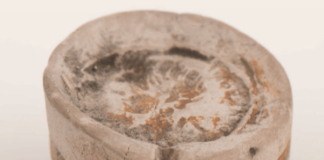
The centre of the world was Rome, its centre of power was the Senate, and Jupiter continued to enthrone the Capitolium – and yet everything was different. How much the Roman Empire had changed can be seen as if under a burning glass on the coins that the new commander-in-chief, Emperor Caesar Divi filius (often simply called Octavian after his former name) had minted. They must have seemed completely novel to contemporaries.
As ever, the principal coin in Roman monetary transactions was the denarius. However, the specimen depicted here features an obverse design unlike anything the Romans had ever seen – at least not on their own currency. We see the head of a young man, about 35 years old at the time of minting. He has well-proportioned and of even facial features. His profile and the meticulously arranged curls are somewhat reminiscent of Alexander the Great. Overall, the portrait appears timeless, almost other-worldly. Hardly anyone believed that Augustus really looked like that. The archaeologist Paul Zanker came up with the term “art face” for this purpose.

The portrait was designed in a distinctly new style. Whoever designed it was most likely not a native Roman. He probably originated from the eastern part of the Empire, perhaps from Egypt, Syria or the small region of Cilicia. Before he entered the emperor’s service, he had worked for other powerful men, for whom he made jewellery, especially gems. He was highly familiar with the imagery of the Hellenistic kings whose realism tended towards gentle idealisation. His name was presumably Dioscurides, and he had probably come to Rome with Julius Caesar. Augustus commissioned him to create a face design that expressed his ideals of power. He designed the portrait of a dynamic and strict but fair ruler.

Around 30 BC, it was still somewhat special for a Roman to have himself immortalised on a sovereign document such as a coin during his lifetime. Julius Caesar, Augustus’ adoptive father, was, among other reasons, murdered for this insolence.
In addition, there was something that actually was missing: a legend. On Roman denarii it had been a tradition for centuries that a legend framed and elaborated on the image. When a ruler, for example a commander (imperator), put his face on a coin, he always felt obliged to list in as much detail as possible the offices that legitimised him to do so. Octavian did not do so. The modesty with which the writing is inscribed on this coin is outrageous. It is only on the reverse that one learns the name of the master of the mint: “IMP(erator) CAESAR”. Of the many titles and offices that he could have stated, he chose only the title that he had already adopted as his first name anyway: Imperator.
The legend can be found in a prominent place on the reverse: as an honorary inscription on a triumphal arch. The base of the arch was grotesquely reduced in size in favour of the depiction of the honoured triumphator. The latter is shown so clearly that although we do not see his facial features, we can easily recognise his triumphal robe, the (crimson) toga. Octavian holds the reins of the four horses (probably white horses) pulling his chariot firmly in his hands. First of all, this coin illustrates the victoriousness of this man in general. Contemporary users of the coin, however, had a vivid image of the triple triumphal procession Octavian was allowed to celebrate in Rome in the summer of 29 BC, after he had returned from the East as victor over Marcus Antony and Cleopatra and their allies. Perhaps this extraordinary event was also the concrete occasion for the minting of this coin issue.
Striking was also the unusually large diameter of the coin. While the denarii had become ever smaller and lighter in the last decades of the Republic, Augustus had this coin struck again with its full weight of 1/84 pounds, i.e. approx. 3.8 g. In addition, the diameter was increased by 1 to 2 mm compared to the usual format. After decades of war, insecurity and economic unrest – so it seemed from looking at these coins – the stability of the good old denarius was now restored.
This restraint in language, together with the enlarged diameter, makes the images all the more striking. The whole focus of the observer rests on what is shown. In order to make this possible, the mint masters had been instructed to carry out the minting with particular care. Whereas otherwise, in the mass minting of Roman denarii, mis-strikes, ruptured blanks and off-centred images are commonplace, the error rate for this issue is remarkably low.
The denarius discussed here is part of the so-called triumphal series. It comprises eleven different types of denarii that combine different obverse and reverse images. Their series of images revolves around Octavian’s triumphalism, who is sometimes depicted as the son of Aphrodite, sometimes as the new Neptune or even Jupiter. This series not only constitutes a unity thematically, but also stylistically. It is the numismatic implementation of what is known in art, particularly in literature, as the Augustan Classicism. From these timelessly effective coins of a self-confident ruler, something already seems to emerge that was not realised until two years later, in 27 BC. Octavian had himself proposed by the senate to accept a new name: Augustus (i.e. the Illustrious One). This denarius shows on what ideological grounds this was founded.
To continue reading:
The numismatic standard work of this period is C. H. V. Sutherland, The Roman Imperial Coinage (RIC), Vol. 1, London 1984, No. 267. Art historical-archaeologically oriented is P. Zanker, The Power of Images in the Age of Augustus. Ann Arbor, MI 1990.
The article is taken from the book “Runde Geschichte” by courtesy of the author.
You can read more about portraits on coins in our extensive series “Human faces”.





